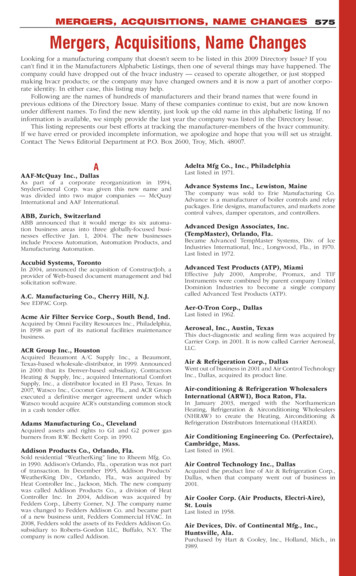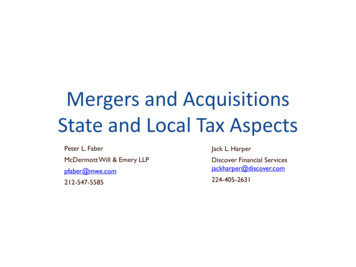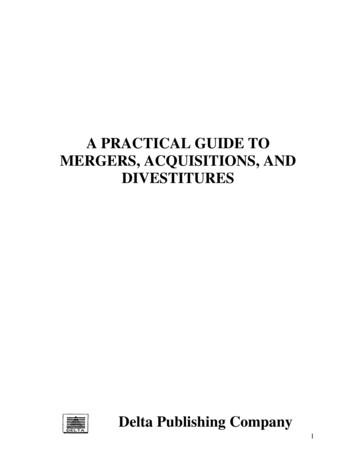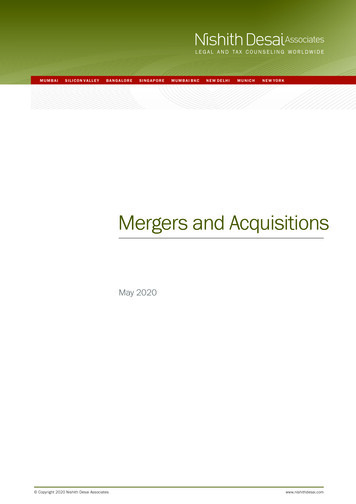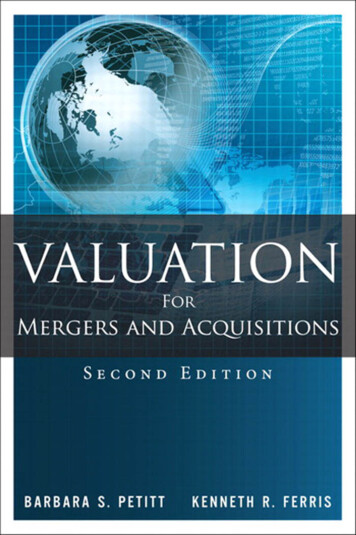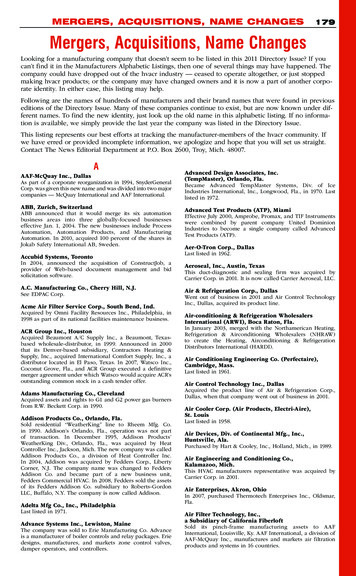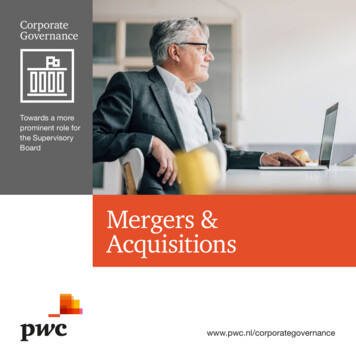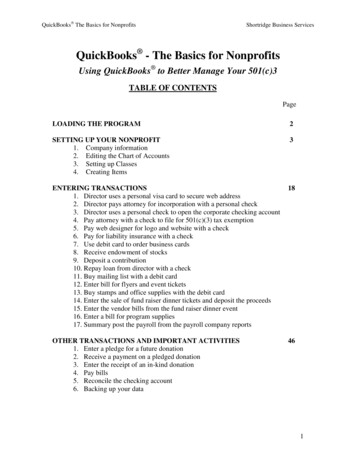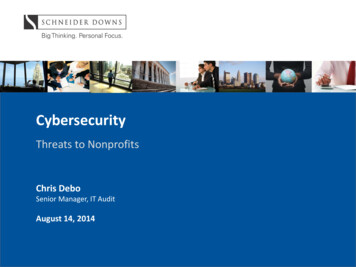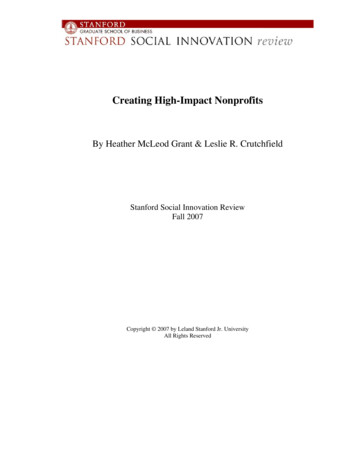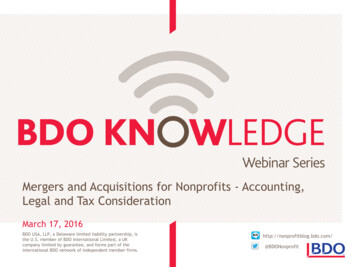
Transcription
Mergers and Acquisitions for Nonprofits - Accounting,Legal and Tax ConsiderationMarch 17, 2016BDO KNOWLEDGE Webinar Series ‒ Mergers and Acquisitions forBDO USA, LLP, a Delaware limited liability partnership, isNonprofits - Accounting, Legal and Tax Considerationthe U.S. member of BDO International Limited, a UKcompany limited by guarantee, and forms part of theinternational BDO network of independent member firms.Page .bdo.com@BDONonprofit@BDONonprofit
PresentersLee Klumpp, CPA, CGMANational Assurance, Director Nonprofit &EducationBDO USA, LLP(703) 336-1497lklumpp@bdo.comKirk L. Brett, EsqPartnerDuval & Stachenfeld LLP(212) 692-5525kbrett@dsllp.comJeffrey J. Schragg, CPA, JDTax PartnerBDO USA, LLP(703) 770-6313jschragg@bdo.comRitesh Lall, CPA, CGMADirector - Assurance ServicesBDO USA, LLP(212) 885-7337rlall@bdo.comBDO KNOWLEDGE Webinar Series ‒ Mergers and Acquisitions forNonprofits - Accounting, Legal and Tax ofitPage 2
AgendaToday, we will discuss the following The difference between a merger or acquisition, The legal process and complexities of a merger or acquisition, byNonprofits and/or with a for-profit entity, Some effective transaction strategies and structures that can beused in these types of transactions, Key accounting and tax considerations, and Best PracticesBDO KNOWLEDGE Webinar Series ‒ Mergers and Acquisitions forNonprofits - Accounting, Legal and Tax ofitPage 3
Legal StructureBDO KNOWLEDGE Webinar Series ‒ Mergers and Acquisitions forNonprofits - Accounting, Legal and Tax ofitPage 4
First Things First Confirm Current Legal StructuresExempt Entities Non-Exempt Entities It’s a “Multi-Species” World Memorandum of Understanding (or LOI)BDO KNOWLEDGE Webinar Series ‒ Mergers and Acquisitions forNonprofits - Accounting, Legal and Tax ofitPage 5
Common Reasons for Mergeror AcquisitionLower Administrative ExpensesConsolidate Donor PoolIncrease Impact on MissionAddress Leadership ChangesFinancial DistressBDO KNOWLEDGE Webinar Series ‒ Mergers and Acquisitions forNonprofits - Accounting, Legal and Tax ofitPage 6
Primary Methods/StructureMerger of EqualsMerger of Un-equalsAcquisition: Sole MembershipBDO KNOWLEDGE Webinar Series ‒ Mergers and Acquisitions forNonprofits - Accounting, Legal and Tax ofitPage 7
Steps Involved in MergerIdentify Merger PartnerNegotiate Terms/DocumentsBoard ApprovalsSign Agreement (With New By-Laws)Approval of State RegulatorConsummate MergerBDO KNOWLEDGE Webinar Series ‒ Mergers and Acquisitions forNonprofits - Accounting, Legal and Tax ofitPage 8
Identifying Merger PartnerDiscuss Goals/Mission of Each PartnerIdentify Benefits/Drawbacks of a MergerDetermine Compatibility of Board MembersDetermine Impact on Donors/Other StakeholdersBDO KNOWLEDGE Webinar Series ‒ Mergers and Acquisitions forNonprofits - Accounting, Legal and Tax ofitPage 9
NegotiationBoard Designee/Subcommittee to Negotiate TermsGovernance Terms: Board Composition; Chairman; Executive DirectorName of the OrganizationPending ProjectsTerm SheetBDO KNOWLEDGE Webinar Series ‒ Mergers and Acquisitions forNonprofits - Accounting, Legal and Tax ofitPage 10
Governance TermsBig Picture for Term Sheet: One Large/Consolidated Board Two Classes of Board MembersAdditional Terms Left for Later – By-LawsBDO KNOWLEDGE Webinar Series ‒ Mergers and Acquisitions forNonprofits - Accounting, Legal and Tax ofitPage 11
Merger Agreement / Plan of MergerImplement the Term SheetProvide for New By-LawsIdentify Initial Directors/OfficersPre-Consummation OperationsBrand/Corporate NameRepresentations and WarrantiesNo Real Remedy For Breach Post-ClosingFunding Operations Pre-MergerConditions to MergerBDO KNOWLEDGE Webinar Series ‒ Mergers and Acquisitions forNonprofits - Accounting, Legal and Tax ofitPage 12
By-LawsImplement Term Sheet as to Big Picture Governance ProvisionsAdditional Governance ItemsSunset Term on Separate AppointmentsTerm of Each Board MemberBoard Officers: Chairman, etc.Executive CommitteeOther CommitteesRemoval of Board MemberReplacement of Board MemberCorporate OfficersBDO KNOWLEDGE Webinar Series ‒ Mergers and Acquisitions forNonprofits - Accounting, Legal and Tax ofitPage 13
ApprovalsBoard of Each EntityAttorney General or Court May Take Months Mission of Each Entity Financial Condition Use of Restricted Assets Effect on Public (i.e., health care)BDO KNOWLEDGE Webinar Series ‒ Mergers and Acquisitions forNonprofits - Accounting, Legal and Tax ofitPage 14
Pre-Closing OperationsOrdinary CourseSignificant or New ProjectsTransition PlanningBDO KNOWLEDGE Webinar Series ‒ Mergers and Acquisitions forNonprofits - Accounting, Legal and Tax ofitPage 15
ConsummationFollowing Approval of Attorney General/CourtCertificate of MergerBDO KNOWLEDGE Webinar Series ‒ Mergers and Acquisitions forNonprofits - Accounting, Legal and Tax ofitPage 16
Post-Closing GovernanceGoverned by New By-LawsPotential Disappointment in Merger of Un-EqualsBDO KNOWLEDGE Webinar Series ‒ Mergers and Acquisitions forNonprofits - Accounting, Legal and Tax ofitPage 17
Overview of AcquisitionAcquirer Becomes Sole Member of TargetSole Member Appoints The BoardNo Attorney General/Court ApprovalTarget Liabilities Remain With TargetBDO KNOWLEDGE Webinar Series ‒ Mergers and Acquisitions forNonprofits - Accounting, Legal and Tax ofitPage 18
Tax ConsiderationsBDO KNOWLEDGE Webinar Series ‒ Mergers and Acquisitions forNonprofits - Accounting, Legal and Tax ofitPage 19
Tax Due Diligence Income taxForms 1023 and 1024 Determination Letters Forms 990, 990-T and States Other Taxes SalesPropertyPayroll (Worker Classification)ExciseState Solicitation ComplianceBDO KNOWLEDGE Webinar Series ‒ Mergers and Acquisitions forNonprofits - Accounting, Legal and Tax ofitPage 20
Structuring Affiliation Agreement Joint Operating Agreement Merger Asset Purchase New Holding Company DissolutionBDO KNOWLEDGE Webinar Series ‒ Mergers and Acquisitions forNonprofits - Accounting, Legal and Tax ofitPage 21
Post Transition Reporting to IRS Final Returns Updating IRC §509 Classifications Employee Integration 401(k)457403(b)Salary levelsHealthcareRight-sizingOperationsBDO KNOWLEDGE Webinar Series ‒ Mergers and Acquisitions forNonprofits - Accounting, Legal and Tax ofitPage 22
Traps for the Unwary Section 337(d)(2) Supporting Organization Updates IRS Exams Post Transition Section 457BDO KNOWLEDGE Webinar Series ‒ Mergers and Acquisitions forNonprofits - Accounting, Legal and Tax ofitPage 23
Not-for-Profit Entities:Mergers and Acquisitions How it compares to Statement of Financial Accounting Standards No. 141(R), (ASC805), Business Combinations (SFAS141 (R)): Similarities (The Acquisition Method) Differences (Recognition of Goodwill) Two types of not-for-profit entities Those that are solely or predominately supported by contributions and returnson investments Those the receive support from fees for services (more “businesslike”)BDO KNOWLEDGE Webinar Series ‒ Mergers and Acquisitions forNonprofits - Accounting, Legal and Tax ofitPage 24
Accounting ConsiderationsBDO KNOWLEDGE Webinar Series ‒ Mergers and Acquisitions forNonprofits - Accounting, Legal and Tax ofitPage 25
Accounting for combinations ofnot-for-profit organizations: Statement of Financial Accounting Standard (SFAS) No. 164 (ASC 958-805)(SFAS No.164), Not-for-Profit Entities: Mergers and Acquisitions distinguishes the differencebetween a merger or an acquisition. Key Concepts: Mergers are accounted for on ‘carryover basis’ - similar to pooling accounting underAccounting Principles Board (APB) Opinion 16 Business Combinations, (ASC 958-805) (APB 16). Acquisitions accounted for on ‘acquisition basis’ - similar to SFAS 141(R). Determining factor of a merger: ceding of control by the governing bodies of two (or more)organizations to a new organization; the governing board of the new entity must be newlyformed, but establishing a new legal entity is not a requirement. Other factors such as relative size, relative dominance of the process and of the combinedentity, and relative financial health, can be considered in judging whether control has beenceded, but are not themselves determinants of a merger vs. an acquisition . All other combinations are acquisitions.BDO KNOWLEDGE Webinar Series ‒ Mergers and Acquisitions forNonprofits - Accounting, Legal and Tax ofitPage 26
Accounting for a merger For mergers we now use the carryover basis of accounting, which adds together thehistorical financial data of the merging entities as of the merger date (not, as underAPB 16, as of the beginning of the fiscal year in which the merger occurs). Financial statements of the period of the merger include data only since the date ofthe merger (except that for a public company (FASB Staff Position (FSP) No. 126-1,(ASC 825), Applicability of Certain Disclosure and Interim Reporting Requirementsfor Obligors for Conduit Debt Securities), pro forma disclosure is required as if themerger had occurred at the beginning of the fiscal year). Conform accounting policies, except, because this is not a ‘fresh-start’, a merger isnot an event that permits the election of accounting options that are restricted tothe entity’s initial acquisition or recognition of an item (or the reversal of a previouselection). Thus, for example, one merging entity’s election of the fair value option(Statement of Financial Accounting Standards No. 159, (ASC 825) The Fair ValueOption for Financial Assets and Financial Liabilities—Including an amendment of FASBStatement No. 115), for a particular financial asset or liability permits neither thenew entity’s election of the fair value option for other financial assets or liabilitiesnor reversal of a previous election of this option.BDO KNOWLEDGE Webinar Series ‒ Mergers and Acquisitions forNonprofits - Accounting, Legal and Tax ofitPage 27
Accounting for a merger(Cont’d) Eliminate effects of any intra-entity transactions. All reclassifications, adjustments, and other changes needed to effect a merger arerolled into opening balances. Since the successor organization after a merger is a new entity, there is no priorperiod statement of activity or cash flows (an ‘opening’ balance sheet may bepresented if desired).BDO KNOWLEDGE Webinar Series ‒ Mergers and Acquisitions forNonprofits - Accounting, Legal and Tax ofitPage 28
Accounting for an acquisition Identifiable assets and liabilities (and any noncontrolling interest) of the acquired entity are broughtin at their fair values at date of acquisition. Exceptions specific to nonprofits: Collections are accounted for in accordance with the policy of the acquirer; conditionalpledges are not recorded; no value is attributed to donor relationships. Exception for leases: Leases are classified (operating vs. capital) according to their terms at lease inception, unless they havebeen modified. If the value of the acquired assets exceeds the sum of the acquired liabilities plus any consideration,the difference is recorded as an inherent contribution and reported as a separate credit in thestatement of activities If the sum of the liabilities plus consideration exceeds the assets, the difference is recorded asgoodwill, except: if the entity is predominantly supported by contributions and/or investment return, the goodwill iswritten off immediately as a separate charge in the statement of activities (‘predominantly supportedby’ means that contributions and investment return are expected to be significantly more than thetotal of all other revenues) Any noncontrolling interests are accounted for in accordance with Statement of Financial AccountingStandards No. 160, Noncontrolling Interest in Consolidated Financial Statements, (ASC 810), (SFAS160).BDO KNOWLEDGE Webinar Series ‒ Mergers and Acquisitions forNonprofits - Accounting, Legal and Tax ofitPage 29
Accounting for an acquisition(Cont’d) Acquisition-related costs are period expenses, except for debt issuance costs. Statement of Financial Accounting Standards No. 142, Goodwill and Other Intangible Assets(ASC 350) (SFAS 142) is made fully effective for not-for-profit entities (goodwill is no longeramortized, rather it is tested for impairment).Exception: SFAS 142 does not apply to:a. The formation of a joint ventureb. The acquisition of assets that do not constitute either a business or a nonprofit activity\c. A combination between entities under common controld. An event in which a not-for-profit entity obtains control of another entity but does notconsolidate that entity, as permitted or required by AICPA SOP No. 94-3. Various descriptive, quantitative, and qualitative (why the merger/acquisition occurred)disclosures are required.BDO KNOWLEDGE Webinar Series ‒ Mergers and Acquisitions forNonprofits - Accounting, Legal and Tax ofitPage 30
Fair Value Accounting ConsiderationsBDO KNOWLEDGE Webinar Series ‒ Mergers and Acquisitions forNonprofits - Accounting, Legal and Tax ofitPage 31
Fair Value UsageThe consideration transferred in an acquisition by a not-for-profit entity shall bemeasured at fair value, which shall be calculated as the sum of the acquisitiondate fair values of the assets transferred by the acquirer and the liabilitiesincurred by the acquirer.The acquirer shall measure the identifiable assets acquired, the liabilitiesassumed, and any noncontrolling interest in the acquiree at their acquisition-datefair values.Fair Value is the price that would be received to sell an asset or paid to transfer aliability in an orderly transaction between market participants at themeasurement date (paragraph 5 of FASB Statement No. 157 (ASC 820), Fair ValueMeasurements).Market participants are buyers and sellers in the principal (or most advantageous)market for the asset or liability that are:a.b.c.d.Independent of the reporting entity; that is, they are not related parties.Knowledgeable, having a reasonable understanding about the asset or liabilityand the transaction based on all available information, including informationthat might be obtained through due diligence efforts that are usual andcustomary.Able to transact for the asset or liability.Willing to transact for the asset or liability; that is, they are motivated butnot forced or otherwise compelled to do so.BDO KNOWLEDGE Webinar Series ‒ Mergers and Acquisitions forNonprofits - Accounting, Legal and Tax ConsiderationLevel 1: Observableinputs that reflectquoted prices foridentical assets orliabilities in activemarkets and assumesthe reporting entity canaccess the markets atthe measurement dateLevel 2: Inputs otherthan quoted marketprices included withinlevel 1 that areobservable eitherdirectly or indirectlyLevel 3: Unobservableinputs reflect thereporting entity's ownassumptions aboutmarket participantassumptions used inpricing an asset itPage 32
Fair Value of Consideration Acquisition date is the date effective control is achieved If the initial accounting for an acquisition is incomplete by the end of the reporting period, the acquire reportsprovisional amounts. The acquirer will retrospectively adjust amounts until the acquirer receives information it wasseeking about facts and circumstances that existed as of the acquisition date or learns the information isunobtainable, but in no cases shall this exceed one year. This is the measurement period. Contingent consideration is recognized at fair value as part of acquisition consideration Acquisition related costs are expensed Preexisting Relationship between the Acquirer and the Acquiree that effectively settled, it is measured at:a.For a preexisting noncontractual relationship (such as a lawsuit), fair valueb.For a preexisting contractual relationship, the lesser of:1)The amount by which the contract is favorable or unfavorable from the perspective of the acquirerwhen compared with pricing for current market transactions for the same or similar items. (Anunfavorable contract is a contract that is unfavorable in terms of current market terms. It is notnecessarily a loss contract in which the unavoidable costs of meeting the obligations under thecontract exceed the economic benefits expected to be received under it.)2)(2) The amount of any stated settlement provisions in the contract available to the counterparty towhom the contract is unfavorable.If (2) is less than (1), the difference is included as part of the acquisition accounting.BDO KNOWLEDGE Webinar Series ‒ Mergers and Acquisitions forNonprofits - Accounting, Legal and Tax ofitPage 33
What is Goodwill?An asset representing the future economic benefits arising from other assets acquired in abusiness combination or an acquisition by a not-for-profit entity that are not individuallyidentified and separately recognized [Paragraph 3(j) of Statement 141(R)].BDO KNOWLEDGE Webinar Series ‒ Mergers and Acquisitions forNonprofits - Accounting, Legal and Tax ofitPage 34
Identifying Intangible Assets and Goodwill The acquirer shall recognize separately from goodwill the identifiable intangible assetsacquired. The asset is identifiable if: Is separable, that is, capable of being separated or divided from the entity and sold,transferred, licensed, rented, or exchanged, either individually or together with arelated contract, identifiable asset, or liability, regardless of whether the entityintends to do so; or Arises from contractual or other legal rights, regardless of whether those rights aretransferable or separable from the entity or from other rights and obligations(paragraph 3(k) of SFAS 141(R)). Exceptions: Donor Relationships Collections Conditional promises to give Assembled and trained workforceBDO KNOWLEDGE Webinar Series ‒ Mergers and Acquisitions forNonprofits - Accounting, Legal and Tax ofitPage 35
Identifying Intangible Assets and Goodwill Goodwill is measured as the excess of (a) over (b) below:a. The aggregate of:- The consideration transferred measured at its acquisition-date fairvalue- The fair value of any noncontrolling interest in the acquiree- In an acquisition achieved in stages, the acquisition-date fair valueof the acquirer’s previously held equity interest in the acquiree.b. The net of the acquisition-date amounts of the identifiable assetsacquired and the liabilities assumed measured in accordance with thisStatement.BDO KNOWLEDGE Webinar Series ‒ Mergers and Acquisitions forNonprofits - Accounting, Legal and Tax ofitPage 36
Identifiable Intangible Assets Marketing Related: Trademarks, trade names, service marks, collectivemarks, certification marks Trade dress (unique color, shape, package design) Newspaper mastheads Internet domain names Noncompetition agreements Artistic Related Plays, operas, ballets Books, magazines, newspapers, other literary works Musical works such as compositions, song lyrics, advertising jingles Pictures, photographs Video and audiovisual material, including motionpictures or films, music videos, television programs. Customer and Donor Related Donor lists Order or Production Backlog Customer contract and related customerrelationships Non-contractual customer relationshipsBDO KNOWLEDGE Webinar Series ‒ Mergers and Acquisitions forNonprofits - Accounting, Legal and Tax ConsiderationContract-Based Licensing, royalty, standstill agreements Advertising, construction, management, serviceor supply contracts Lease agreements (whether the acquiree is thelessee or the lessor) Construction permits Franchise agreements Operating and broadcast rights Employment contracts Use rights such as drilling, water, air, timbercutting, and route authorities.Technology Based Patented technology Computer software and mask works Unpatented technology Databases, including title plants Trade secrets, such as secret formulas,processes, age 37
Items to Support in Fair Value Determination Controls over the process used to determine fair value measurements, including, for example, controls over data and thesegregation of duties between those committing the entity to the underlying transactions and those responsible forundertaking the valuations. The expertise and experience of those persons determining the fair value measurements. The role that information technology has in the process. The types of accounts or transactions requiring fair value measurements or disclosures (for example, whether the accountsarise from the recording of routine and recurring transactions or whether they arise from nonroutine or unusualtransactions). The extent to which the entity’s process relies on a service organization to provide fair value measurements or the datathat supports the measurement. When an entity uses a service organization, the auditor considers the requirements of SASNo. 70, Service Organizations (AICPA, Professional Standards, vol. 1, AU sec. 324), as amended. The extent to which the entity engages or employs specialists in determining fair value measurements and disclosures. The significant management assumptions used in determining fair value. The documentation supporting management’s assumptions. The process used to develop and apply management assumptions, including whether management used available marketinformation to develop the assumptions. The process used to monitor changes in management’s assumptions. The integrity of change controls and security procedures for valuation models and relevant information systems, includingapproval processes. The controls over the consistency, timeliness, and reliability of the data used in valuation models.BDO KNOWLEDGE Webinar Series ‒ Mergers and Acquisitions forNonprofits - Accounting, Legal and Tax ofitPage 38
Analyze FinancialPerformance andForecastsDetermineAppropriateValuation Method(s)Prepare Models andSupportingSchedulesBDO KNOWLEDGE Webinar Series ‒ Mergers and Acquisitions forNonprofits - Accounting, Legal and Tax ConsiderationPrepare ReportGather RelevantCompany DataInterview KeyManagementResearch Industryand EconomicFactorsSearch Databasesfor Market DataAnalysisDue DiligenceValuation ProcessSummarize FactsDescribeAssumptions andAnalysisOutline MethodologySelection andApplicationDescribe tPage 39
Goodwill Acquired Recognized as goodwill as of the acquisition date if the combined entity is supported byresources other than contributions and returns on investments. Measured as the excess of (a) over (b):(a) the aggregate of:(1) the consideration transferred measured at its acquisition-date fair value;(2) the fair value of any non-controlling interest in the acquiree; and(3) in an acquisition achieved in stages, the acquisition-date fair value of theacquirer’s previously held equity interest in the acquiree.(b) The net of the acquisition-date amounts of the identifiable assets acquiredand the liabilities assumed. However, if the combined entity is predominately supported by contributions and returnon investments, the excess of (a) over (b) is recognized as a separate charge in thestatement of activities as of the acquisition date rather than as goodwill.BDO KNOWLEDGE Webinar Series ‒ Mergers and Acquisitions forNonprofits - Accounting, Legal and Tax ofitPage 40
Goodwill Acquired(cont’d) Consider all relevant qualitative and quantitative factors in determining the expectednature of the predominant source of support. If no consideration is transferred, the goodwill or the separate charge would be theexcess of liabilities assumed over assets acquired.BDO KNOWLEDGE Webinar Series ‒ Mergers and Acquisitions forNonprofits - Accounting, Legal and Tax ofitPage 41
Transition for Previously Recognized Goodwill For combined entities predominately supported by contributions and returns oninvestments, write off previously recognized goodwill by a separate charge in thestatement of activities at the acquisition date. For combined entities not predominately supported by contributions and returns oninvestments: 1) establish the reporting units [Paragraph 54 of Statement 142] and 2)perform a transitional goodwill impairment evaluation [Paragraphs 55-58 of Statement142].BDO KNOWLEDGE Webinar Series ‒ Mergers and Acquisitions forNonprofits - Accounting, Legal and Tax ofitPage 42
Goodwill and Other Intangible AssetsSFAS No.142 has been amended to apply to not-for-profit entities for goodwill and otherintangible assets acquired in an acquisition by a not-for-profit entity.BDO KNOWLEDGE Webinar Series ‒ Mergers and Acquisitions forNonprofits - Accounting, Legal and Tax ofitPage 43
What is meant by“Predominately Supported”?SFAS 164 defines “predominately supported” to mean that contributions and returns oninvestments are expected to be significantly more than the total of all other sources ofrevenue.BDO KNOWLEDGE Webinar Series ‒ Mergers and Acquisitions forNonprofits - Accounting, Legal and Tax ofitPage 44
What is a Contribution?Statement of Financial Accounting Standards No. 116, (ASC 605) (SFAS 116) Accountingfor Contributions Received and Contributions Made defines a contribution as anunconditional transfer of cash or other assets to an entity or a settlement or cancellationof its liabilities in a voluntary nonreciprocal transfer by another entity acting other thanas an owner.An inherent contribution is made if an entity voluntarily transfers assets (or net assets)or performs services for another entity in exchange either for no assets or for assets ofsubstantially lower value and unstated rights or privileges of a commensurate value arenot involved.BDO KNOWLEDGE Webinar Series ‒ Mergers and Acquisitions forNonprofits - Accounting, Legal and Tax ofitPage 45
Contribution Received Recognize as a separate credit in the statement of activities as of the acquisition date. Measured as the excess of (b) over (a):(a) the aggregate of:(1) the consideration transferred measured at its acquisition-date fair value;(2) the fair value of any non-controlling interest in the acquiree; and(3) in an acquisition achieved in stages, the acquisition-date fair value of theacquirer’s previously held equity interest in the acquiree.(b) The net of the acquisition-date amounts of the identifiable assets acquiredand the liabilities assumed. If no consideration is transferred, the excess amount would be the excess of assetsacquired over liabilities assumed.BDO KNOWLEDGE Webinar Series ‒ Mergers and Acquisitions forNonprofits - Accounting, Legal and Tax ofitPage 46
Consideration Transferred In acquisitions by not-for-profit entities Measured at the acquisition-date fair value. The sum of the assets transferred and the liabilities incurred. Forms: Cash. Other assets. A business or a nonprofit activity of the acquirer. Contingent consideration.BDO KNOWLEDGE Webinar Series ‒ Mergers and Acquisitions forNonprofits - Accounting, Legal and Tax ofitPage 47
Accounting GuidanceBDO KNOWLEDGE Webinar Series ‒ Mergers and Acquisitions forNonprofits - Accounting, Legal and Tax ofitPage 48
Relevant GuidanceSFAS 164 (ASC 958-805): Statement of Financial Accounting Standards No. 164, Not-forProfit Entities: Mergers and Acquisitions.FASB Staff Position (FSP) No. SFAS 126-1 (ASC 825): Applicability of Certain Disclosure andInterim Reporting Requirements for Obligors for Conduit Debt SecuritiesSFAS 141(R) (ASC 805): Statement of Financial Accounting Standards No. 141(R), BusinessCombinations.SFAS 142 (ASC 350): Statement of Financial Accounting Standards No. 142, Goodwill andOther Intangible Assets.SFAS 116 (ASC 958-605): Statement of Financial Accounting Standards No. 116, Account
Mar 17, 2016 · Statement of Financial Accounting Standard (SFAS) No. 164 (ASC 958-805)(SFAS No. 164), Not-for-Profit Entities: Mergers and Acquisitions distinguishes the difference between a merger or an acquisition. Key Concepts: Mergers are accounted for o
